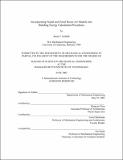| dc.contributor.advisor | Qingyan Chen. | en_US |
| dc.contributor.author | Griffith, Brent T. (Brent Thomas), 1967- | en_US |
| dc.contributor.other | Massachusetts Institute of Technology. Dept. of Mechanical Engineering. | en_US |
| dc.date.accessioned | 2006-12-14T20:09:39Z | |
| dc.date.available | 2006-12-14T20:09:39Z | |
| dc.date.copyright | 2002 | en_US |
| dc.date.issued | 2002 | en_US |
| dc.identifier.uri | http://hdl.handle.net/1721.1/34970 | |
| dc.description | Thesis (S.M.)--Massachusetts Institute of Technology, Dept. of Mechanical Engineering, 2002. | en_US |
| dc.description | This electronic version was submitted by the student author. The certified thesis is available in the Institute Archives and Special Collections. | en_US |
| dc.description | Includes bibliographical references (p. 105-111). | en_US |
| dc.description.statementofresponsibility | by Brent T. Griffith. | en_US |
| dc.format.extent | 193 p. | en_US |
| dc.format.extent | 3611711 bytes | |
| dc.format.extent | 3965005 bytes | |
| dc.format.mimetype | application/pdf | |
| dc.format.mimetype | application/pdf | |
| dc.language.iso | eng | en_US |
| dc.publisher | Massachusetts Institute of Technology | en_US |
| dc.relation.requires | CDROM contains Air model toolkit; files have the extensions of .txt, .doc, .pdf, and .zip. | en_US |
| dc.rights | M.I.T. theses are protected by copyright. They may be viewed from this source for any purpose, but reproduction or distribution in any format is prohibited without written permission. See provided URL for inquiries about permission. | en_US |
| dc.rights.uri | http://dspace.mit.edu/handle/1721.1/7582 | |
| dc.subject | Mechanical Engineering. | en_US |
| dc.title | Incorporating nodal and zonal room air models into building energy calculation procedures | en_US |
| dc.type | Thesis | en_US |
| dc.description.degree | S.M. | en_US |
| dc.contributor.department | Massachusetts Institute of Technology. Department of Mechanical Engineering | |
| dc.identifier.oclc | 51805621 | en_US |
| dc.audience.educationlevel | This research focuses on developing a framework and computer code for coupling detailed air models with building energy and load calculations that can be distributed as a toolkit. The complete-mixing model for room air has long been used for such calculations although there are concerns that it might be deficient when air temperature is not uniform because of buoyancy-driven airflow. Nodal models developed by Mundt (1996) and Rees (1998) were implemented, and a new momentum-zonal model developed, for testing the framework with load-calculation routines based on Pederson's (2001) implementation of the Heat Balance Model. The Heat Balance Model has been reformulated to use an array of zone air temperatures. The coupling framework defines near-surface air temperatures for surface convection calculations and determines system flow rates using model predictions for temperature at the air system returns and a room air control location. The toolkit facilitates incorporating room air modeling into building simulation software and provides a convenient method of testing different air models with Pederson's load routines. The toolkit contains a versatile test program that performs detailed, hourly load calculations for a single thermal zone where both network and three-dimensional air flow models have been tightly coupled to the load calculation routines. In running the test program, the effect of air models on sensible load was found to be minor except where modeling involved aggressive diurnal thermal mass strategies or operative temperature controlling. Displacement ventilation nodal models, such as Rees and Haves, appear practical to implement in load and energy programs and should improve results for air system flow rate and return air temperatures. Results show increases of about a factor of four in computing time for nodal models compared to the mixing model. A momentum-zonal model was developed based on a finite-volume formulation of the Eüler equation for inviscid flow and found to produce reasonable results with coupled computing time increases of about a factor of 100 or more. This research also investigates pressure-zonal air models by Lin (1999) and Inard et al. (1996) and finds that the non-linear formulations appear problematic for building simulation. | |
